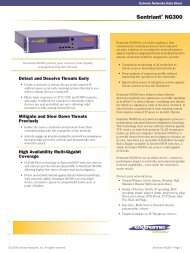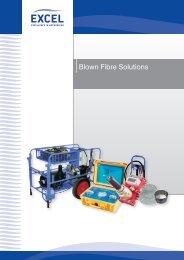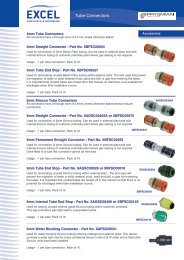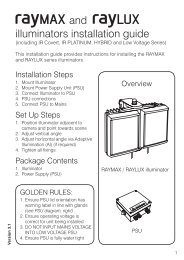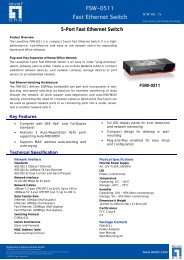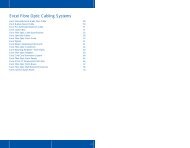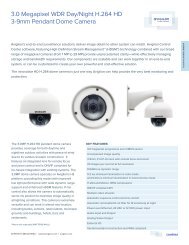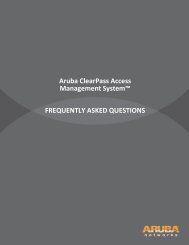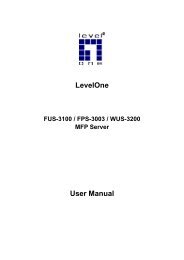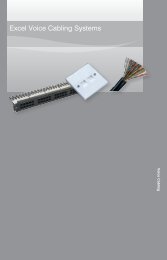WAB-3001/WAB-3002 11b/g Wireless Outdoor Client ... - LevelOne
WAB-3001/WAB-3002 11b/g Wireless Outdoor Client ... - LevelOne
WAB-3001/WAB-3002 11b/g Wireless Outdoor Client ... - LevelOne
- No tags were found...
Create successful ePaper yourself
Turn your PDF publications into a flip-book with our unique Google optimized e-Paper software.
<strong>WAB</strong>-<strong>3001</strong>/<strong>WAB</strong>-<strong>3002</strong><strong>11b</strong>/g <strong>Wireless</strong> <strong>Outdoor</strong> <strong>Client</strong> Bridge/APUser’s ManualVersion: 1.0
<strong>WAB</strong>-<strong>3001</strong>/<strong>WAB</strong>-<strong>3002</strong> <strong>11b</strong>/g <strong>Wireless</strong> <strong>Outdoor</strong> <strong>Client</strong> Bridge/AP Version 1.05.2.6 SAVE / RELOAD SETTINGS, RESET TO DEFAULT..........................................................................385.2.7 PASSWORD ..................................................................................................................................395.3 TCP/IP SETTINGS........................................................................................................................405.3.1 LAN INTERFACE .........................................................................................................................401. STATIC IP ADDRESS.........................................................................................................................402. DHCP CLIENT .................................................................................................................................413. DHCP SERVER.................................................................................................................................425.3.2 SNMP SETTINGS.........................................................................................................................435.4 WIRELESS ...................................................................................................................................435.4.1 BASIC SETTINGS..........................................................................................................................445.4.2 ADVANCED SETTINGS .................................................................................................................455.4.3 SECURITY....................................................................................................................................471. ENCRYPTION DISABLED...................................................................................................................472. WEP 64-BIT / 128-BIT......................................................................................................................483. WPA / WPA2 / WPA2 MIXED PASSPHRASE....................................................................................494. WPA / WPA2 / WPA2 MIXED RADIUS AUTHENTICATION............................................................505.4.4 SITE SURVERY.............................................................................................................................516 FORGOT THE ID/PASSWORD ......................................................................................................52Console cable explanation............................................................................................................................... 52Supper terminal steps ...................................................................................................................................... 53APPENDIX B – FCC INTERFERENCE STATEMENT.........................................................................58APPENDIX C – IC STATEMENT.............................................................................................................593
<strong>WAB</strong>-<strong>3001</strong>/<strong>WAB</strong>-<strong>3002</strong> <strong>11b</strong>/g <strong>Wireless</strong> <strong>Outdoor</strong> <strong>Client</strong> Bridge/AP Version 1.0Revision HistoryVersion Date Notes1.42.01 2008-06-30 Initial Version4
<strong>WAB</strong>-<strong>3001</strong>/<strong>WAB</strong>-<strong>3002</strong> <strong>11b</strong>/g <strong>Wireless</strong> <strong>Outdoor</strong> <strong>Client</strong> Bridge/AP Version 1.01 IntroductionThe <strong>LevelOne</strong> <strong>WAB</strong>-<strong>3001</strong>/<strong>WAB</strong>-<strong>3002</strong> <strong>Outdoor</strong> <strong>Wireless</strong> Bridge / <strong>Client</strong> Router / AP /Repeater operates seamlessly in the 2.4 GHz frequency spectrum supporting the802.<strong>11b</strong> (2.4GHz, 11Mbps) and faster 802.11g (2.4GHz, 54Mbps) wirelessstandards. It's the best way to add wireless capability to your existing wired network,or to add bandwidth to your wireless installation.<strong>WAB</strong>-<strong>3001</strong>/<strong>WAB</strong>-<strong>3002</strong> Series has high transmitted output power and high receivablesensitivity. High output power and high sensitivity can extend range and coverage toreduce the roaming between APs to get more stability wireless connection. It alsocan reduce the expense of equipment in the same environment.To protect your wireless connectivity, it can encrypt all wireless transmissionsthrough 64/128-bit WEP data encryption and also supports WPA/WPA2. The MACaddress filter lets you select exactly which stations should have access to yournetwork.This chapter describes the features & benefits, package contents, applications, andnetwork configuration.5
<strong>WAB</strong>-<strong>3001</strong>/<strong>WAB</strong>-<strong>3002</strong> <strong>11b</strong>/g <strong>Wireless</strong> <strong>Outdoor</strong> <strong>Client</strong> Bridge/AP Version 1.01.1 Features & BenefitsFeaturesHigh Speed Data Rate Up to 54MbpsHigh Output Power EIRP up to 35 dBm(with 9 dBi Patch Antenna)IEEE 802.<strong>11b</strong>/g CompliantWatertight and WeatherproofSNMP Remote ConfigurationManagementPoint-to-point, Point-to-multipoint<strong>Wireless</strong> ConnectivityWPA2/WPA/ IEEE 802.1x supportHide SSID (AP Mode)DHCP <strong>Client</strong>/ ServerWDS (<strong>Wireless</strong> Distributed System)Universal RepeaterMAC address filtering (AP mode)User isolation support (AP mode)PPPoE function support (CR mode)Power-over-Ethernet (IEEE802.3af)Keep personal settingBenefitsCapable of handling heavy data payloadssuch as MPEG video streamingExcellent output power spreads the operationdistanceFully Interoperable with IEEE802.<strong>11b</strong>/IEEE802.11g compliant devicesAvoid water invaded and weather corrodedfor outdoor environmentHelp administrators to remotely configure ormanage the Access Point easily.Let users transfer data between twobuildings or multiple buildingsPowerful data securityAvoids unallowable users sharing bandwidth,increases efficiency of the networkSimplifies network administrationMake wireless AP and Bridge modesimultaneously as a wireless repeaterThe easiest way to expand your wirelessnetwork's coverageEnsures secure network connectionProtect the private network between clientusers.Easy to access internet via ISP serviceauthenticationFlexible Access Point locations and costsavingsKeep the latest setting when firmwareupgrade6
<strong>WAB</strong>-<strong>3001</strong>/<strong>WAB</strong>-<strong>3002</strong> <strong>11b</strong>/g <strong>Wireless</strong> <strong>Outdoor</strong> <strong>Client</strong> Bridge/AP Version 1.01.2 Package ContentsOpen the package carefully, and make sure that none of the items listed below aremissing. Do not discard the packing materials, in case of return; the unit must beshipped in its original package.<strong>Outdoor</strong> <strong>Wireless</strong> <strong>Client</strong> Bridge unitPoI-2000 Power over Ethernet InjectorUser’s manual CD-ROMWall/Pole mounting kitWaterproof kit for Ethernet cable1.3 <strong>Outdoor</strong> Unit DescriptionB) <strong>WAB</strong>-<strong>3002</strong>External AntennaConnector (N-type)A) <strong>WAB</strong>-<strong>3001</strong><strong>Outdoor</strong> Unit with built-in9dBi antennaEthernet cable7
<strong>WAB</strong>-<strong>3001</strong>/<strong>WAB</strong>-<strong>3002</strong> <strong>11b</strong>/g <strong>Wireless</strong> <strong>Outdoor</strong> <strong>Client</strong> Bridge/AP Version 1.01.4 Ethernet cable water proof kit Install GuideInstall the Ethernet cable with the waterproof kits shown as below pictures 1~4.8
<strong>WAB</strong>-<strong>3001</strong>/<strong>WAB</strong>-<strong>3002</strong> <strong>11b</strong>/g <strong>Wireless</strong> <strong>Outdoor</strong> <strong>Client</strong> Bridge/AP Version 1.01.5 Mounting Install Guidea) Pole mounting1) Lock the bracket on device.2) Using hoop to fix on pole and bind with U-clamp.3) Adjust degree of device.4) Using washer screw to lock with device.9
<strong>WAB</strong>-<strong>3001</strong>/<strong>WAB</strong>-<strong>3002</strong> <strong>11b</strong>/g <strong>Wireless</strong> <strong>Outdoor</strong> <strong>Client</strong> Bridge/AP Version 1.0b) Wall mounting1) Lock the bracket on device.2) Lock the wall mount bracket on wall..3) Adjust degree of device.4) Using washer screw to lock with device.10
<strong>WAB</strong>-<strong>3001</strong>/<strong>WAB</strong>-<strong>3002</strong> <strong>11b</strong>/g <strong>Wireless</strong> <strong>Outdoor</strong> <strong>Client</strong> Bridge/AP Version 1.01.6 System RequirementsThe following are the minimum system requirements in order configure thedevice. PC/AT compatible computer with an Ethernet interface. Operating system that supports HTTP web-browser1.7 ApplicationsThe wireless LAN products are easy to install and highly efficient. The following listdescribes some of the many applications made possible through the power andflexibility of wireless LANs:a) Difficult-to-wire environmentsThere are many situations where wires cannot be laid easily. Historicbuildings, older buildings, open areas and across busy streets make theinstallation of LANs either impossible or very expensive.b) Temporary workgroupsConsider situations in parks, athletic arenas, exhibition centers, disasterrecovery,temporary offices and construction sites where one wants atemporary WLAN established and removed.c) The ability to access real-time informationDoctors/nurses, point-of-sale employees, and warehouse workers canaccess real-time information while dealing with patients, servingcustomers and processing information.d) Frequently changed environmentsShow rooms, meeting rooms, retail stores, and manufacturing sites wherefrequently rearrange the workplace.e) Small Office and Home Office (SOHO) networksSOHO users need a cost-effective, easy and quick installation of a smallnetwork.f) <strong>Wireless</strong> extensions to Ethernet networksNetwork managers in dynamic environments can minimize the overheadcaused by moves, extensions to networks, and other changes withwireless LANs.g) Wired LAN backupNetwork managers implement wireless LANs to provide backup formission-critical applications running on wired networks.h) Training/Educational facilitiesTraining sites at corporations and students at universities use wirelessconnectivity to ease access to information, information exchanges, andlearning.1.8 Network ConfigurationTo better understand how the wireless LAN products work together to create awireless network, it might be helpful to depict a few of the possible wireless LAN PCcard network configurations. The wireless LAN products can be configured as:11
<strong>WAB</strong>-<strong>3001</strong>/<strong>WAB</strong>-<strong>3002</strong> <strong>11b</strong>/g <strong>Wireless</strong> <strong>Outdoor</strong> <strong>Client</strong> Bridge/AP Version 1.0a) Ad-hoc (or peer-to-peer) for departmental or SOHO LANs.b) Infrastructure for enterprise LANs.a) Ad-hoc Mode (Bridge)This is the simplest network configuration with several computersequipped with the PC Cards that form a wireless network whenever theyare within range of one another. In ad-hoc mode, each client is peer-topeer,would only have access to the resources of the other client anddoes not require an access point. This is the easiest and least expensiveway for the SOHO to set up a wireless network. The image below depictsa network in ad-hoc mode.b) Infrastructure Mode (AP <strong>Client</strong>)The infrastructure mode requires the use of an access point (AP). In this mode, allwireless communication between two computers has to be via the AP. It doesn’tmatter if the AP is stand-alone or wired to an Ethernet network. If used in standalone,the AP can extend the range of independent wireless LANs by acting as arepeater, which effectively doubles the distance between wireless stations. Theimage below depicts a network in infrastructure mode.12
<strong>WAB</strong>-<strong>3001</strong>/<strong>WAB</strong>-<strong>3002</strong> <strong>11b</strong>/g <strong>Wireless</strong> <strong>Outdoor</strong> <strong>Client</strong> Bridge/AP Version 1.02 Understanding the Hardware2.1 Hardware Installation1. Place the outdoor unit in an appropriate pace using the mounting kit.2. Run the Ethernet cable indoors and plug it into the PoE injector port labeled“AP/Router”.3. Plug one end of another Ethernet cable into your PC/Notebook and the other endinto the PoE injector port labeled “Network”.4. Insert the DC-inlet of the power adapter into the PoE injector port labeled“DC240V” and the other end into the power socket on the wall.This diagram depicts the hardware configurationPCEthernetPoE InjectorEthernet<strong>Outdoor</strong> UnitAC/DC cablePower Outlet2.2 IP Address ConfigurationThis device can be configured as a Bridge or Access Point. The default IP addressof the device is 192.168.1.1. In order to log into this device, you must first configurethe TCP/IP settings of your PC/Notebook.1. In the control panel, double click Network Connections and then double click onthe connection of your Network Interface Card (NIC). You will then see thefollowing screen.13
<strong>WAB</strong>-<strong>3001</strong>/<strong>WAB</strong>-<strong>3002</strong> <strong>11b</strong>/g <strong>Wireless</strong> <strong>Outdoor</strong> <strong>Client</strong> Bridge/AP Version 1.02. Select Internet Protocol (TCP/IP) and then click on the Properties button. Thiswill allow you to configure the TCP/IP settings of your PC/Notebook.3. Select Use the following IP Address radio button and then enter the IP addressand subnet mask. Ensure that the IP address and subnet mask are on the samesubnet as the device.For Example: Device IP address: 192.168.1.1PC IP address: 192.168.1.10PC subnet mask: 255.255.255.04. Click on the OK button to close this window, and once again to close LANproperties window.14
<strong>WAB</strong>-<strong>3001</strong>/<strong>WAB</strong>-<strong>3002</strong> <strong>11b</strong>/g <strong>Wireless</strong> <strong>Outdoor</strong> <strong>Client</strong> Bridge/AP Version 1.03 Switch between Bridge/Bridge Router/APThis device can be configured as a Bridge or Access Point. The default IP addressof the device is 192.168.1.1 in Bridge mode. This chapter will describe the steps toswitch from Bridge to Access Point and Access Point to Bridge.3.1 Bridge/Bridge Router to Access Point1 Enter the default IP address (192.168.1.1) of the bridge into the address bar ofthe web-browser.2 the default user name is levelone3 the default password is levelone4 Once you have logged in, click on the Operation Mode link under theManagement menu.5 Since this device is currently in Bridge mode, the Bridge radio button will beselected by default.6 Select the AP radio button to and then click on the Apply Change to switch theoperation mode to Access Point.7 Wait for about 1 minute and the device will automatically restart into AccessPoint mode.15
<strong>WAB</strong>-<strong>3001</strong>/<strong>WAB</strong>-<strong>3002</strong> <strong>11b</strong>/g <strong>Wireless</strong> <strong>Outdoor</strong> <strong>Client</strong> Bridge/AP Version 1.03.2 Access Point to Bridge/Bridge Router1 Enter the default IP address (192.168.1.2) of the bridge into the address bar ofthe web-browser.2 By default, a user name and password has not been configured. If you haveconfigured a user name and password, please enter them into the field tocontinue3 Once you have logged in, click on the Operation Mode link under theManagement menu.4 Since this device is currently in Access Point mode, the AP radio button will beselected by default.5 Select the Bridge or Bridge Router radio button to and then click on the ApplyChange to switch the operation mode to Bridge.6 Wait for about 1 minute and the device will automatically restart into Bridgemode.16
<strong>WAB</strong>-<strong>3001</strong>/<strong>WAB</strong>-<strong>3002</strong> <strong>11b</strong>/g <strong>Wireless</strong> <strong>Outdoor</strong> <strong>Client</strong> Bridge/AP Version 1.04 Bridge/Bridge Router Mode – WebConfiguration4.1 Logging In• To configure the Bridge through the web-browser, enter the IP address of the Bridge(default: 192.168.1.1) into the address bar of the web-browser and press Enter.• Make sure that the Bridge and your computers are on the same subnet. Refer toChapter 2 in order to configure the IP address of your computer.• Username:levelone; Password:levelone• After logging in you will graphical user interface (GUI) of the bridge. The navigationdrop-down menu on left is divided into three main sections:1. Management: This includes operation mode, status, statistics, logs, upgradefirmware, save/reload settings, and password.2. TCP/IP Settings: This includes the configuration of the LAN port and settings forthe LAN IP, subnet mask, DHCP client, spanning tree and MAC cloning.3. <strong>Wireless</strong>: This includes the basic, advanced, security and site-survey settings forthe wireless interface.• The Bridge status page is also displayed once you have logged in. This includesdetails about the system, wireless, and TCP/IP configuration.17
<strong>WAB</strong>-<strong>3001</strong>/<strong>WAB</strong>-<strong>3002</strong> <strong>11b</strong>/g <strong>Wireless</strong> <strong>Outdoor</strong> <strong>Client</strong> Bridge/AP Version 1.0• Systemo Uptime: Duration of time since the device was last reset.o Firmware version: Version of the firmware that is currently loaded on thedevice.• <strong>Wireless</strong> Configuration:o Mode: <strong>Wireless</strong> configuration mode such as client bridge, AP, or WDS.o Band: Frequency and IEEE 802.11 operation mode (b-only, g-only, or b+g).o SSID: The name used to identify the wireless network.o Channel Number: The channel used to communicate on the wirelessnetwork.o Encryption: The type of security used on this network. It may be disabled,WEP, WPA, etc.o BSSID: The MAC address of the SSID.o State: The current state of the bridge. It may be scanning or associated ordisabled.o Signal Strength: The signal strength of the wireless device.o Noise Level: The level of interference.• TCP/IP Configuration:o Attain IP Protocol: The IP address setting may be fixed or static.o IP Address: Displays the current IP address of the LAN port.o Subnet Mask: Displays the current subnet mask for the IP address.o Default Gateway: Displays the default gateway for the device.o DHCP: Displays the DHCP setting.o MAC Address: Displays the MAC address of the device.18
<strong>WAB</strong>-<strong>3001</strong>/<strong>WAB</strong>-<strong>3002</strong> <strong>11b</strong>/g <strong>Wireless</strong> <strong>Outdoor</strong> <strong>Client</strong> Bridge/AP Version 1.04.2 Management• Click on the Management link on the navigationdrop-down menu. You will then see five options:operation mode, status, statistics, log, upgradefirmware, save/reload settings, and password.Each option is described below.4.2.1 Operation Mode• Click on the Operation Mode link under the Management menu. The OperationMode allows you to switch from <strong>Client</strong> Bridge to Access Point mode.• Select the AP, Bridge or Bridge Router and then click on the Apply Change button.19
<strong>WAB</strong>-<strong>3001</strong>/<strong>WAB</strong>-<strong>3002</strong> <strong>11b</strong>/g <strong>Wireless</strong> <strong>Outdoor</strong> <strong>Client</strong> Bridge/AP Version 1.0• Please wait and then enter the specified IP address into the web-browser. Theprevious settings will be retained in AP mode. .• Refer to Chapter 5 to learn how to configure this device in Access Point mode.4.2.2 Status• Click on the Status link under the Management menu. The Status page is the firstpage that is displayed once you have logged in. This includes details about thesystem, wireless, and TCP/IP configuration.• Systemo Uptime: Duration of time since the device was last reset.o Firmware version: Version of the firmware that is currently loaded on thedevice.• <strong>Wireless</strong> Configuration:o Mode: <strong>Wireless</strong> configuration mode such as client bridge, AP, or WDS.o Band: Frequency and IEEE 802.11 operation mode (b-only, g-only, or b+g).o SSID: The name used to identify the wireless network.o Channel Number: The channel used to communicate on the wirelessnetwork.o Encryption: The type of security used on this network. It may be disabled,WEP, WPA, etc.o BSSID: The MAC address of the SSID.o State: The current state of the bridge. It may be scanning or associated ordisabled.o Signal Strength: The signal strength of the wireless device.20
<strong>WAB</strong>-<strong>3001</strong>/<strong>WAB</strong>-<strong>3002</strong> <strong>11b</strong>/g <strong>Wireless</strong> <strong>Outdoor</strong> <strong>Client</strong> Bridge/AP Version 1.0o Noise Level: The level of interference.• TCP/IP Configuration:o Attain IP Protocol: The IP address setting may be fixed or static.o IP Address: Displays the current IP address of the LAN port.o Subnet Mask: Displays the current subnet mask for the IP address.o Default Gateway: Displays the default gateway for the device.o DHCP: Displays the DHCP setting.o MAC Address: Displays the MAC address of the device.4.2.3 Statistics• Click on the Statistics link under the Management menu. This page displays thenumber of sent and received packets on the Ethernet and <strong>Wireless</strong> interface.• Since the packet counter is not dynamic, you must click on the Refresh button forthe most recent statistics.4.2.4 Log• Click on the Log link under the Management menu. The Log page displays a list ofevents that are triggered on the Ethernet and <strong>Wireless</strong> interface. This log can bereferred when an unknown error occurs on the system or when a report needs to besent to the technical support department for debugging purposes.21
<strong>WAB</strong>-<strong>3001</strong>/<strong>WAB</strong>-<strong>3002</strong> <strong>11b</strong>/g <strong>Wireless</strong> <strong>Outdoor</strong> <strong>Client</strong> Bridge/AP Version 1.0• In order for the log to record all the events, you must first place a check in theEnable Log or Enable Remote Log (Log Server required) check box.• Select system all or wireless depending on the type of events you want recorded.• Since the log is not dynamic, you must click on the Refresh button for the mostrecent events, or click on the Clear button to clear the log.4.2.5 Upgrade Firmware• Click on the Upgrade Firmware link under the Management menu. This page isused to upgrade the firmware on the device. Make sure that downloaded theappropriate firmware from your vendor.• Click on the Browse button and then select the appropriate firmware and then clickon the Upload button.Note: The upgrade process may take about 1 minute to complete. Do not power offthe device during this process as it may crash the device and make it unusable. Thedevice will restart automatically once the upgrade is complete.22
<strong>WAB</strong>-<strong>3001</strong>/<strong>WAB</strong>-<strong>3002</strong> <strong>11b</strong>/g <strong>Wireless</strong> <strong>Outdoor</strong> <strong>Client</strong> Bridge/AP Version 1.0• Enter a user name into the first field.• Enter a password into the New Password field and then re-type the password intothe Confirmed Password field. Then click on the Apply Changes button.• By clicking on the Reset button, the user name and password fields will becomeblank indicating that the username and password has been disabled.4.3 TCP/IP Settings• Click on the TCP/IP Settings link on the navigationdrop-down menu. You will then see the LAN Interfaceand SNMP option. The options is described in detailbelow.4.3.1 LAN Interface• Click on the LAN Interface link under the TCP/IP Settings menu. Using this optionyou may change the IP address of the device as well as toggle the DHCP setting.• IP Address: Enter the IP address.• Subnet Mask: Enter the subnet mask for the IP address.• Default Gateway: Enter the IP address for the default gateway.• DHCP: If this device is a DHCP client and will receive its IP settings from a DHCPserver, then select Enabled from the drop-down list. Enabling the DHCP client willdisable the IP address, subnet mask, and default gateway fields. If the DHCP option24
<strong>WAB</strong>-<strong>3001</strong>/<strong>WAB</strong>-<strong>3002</strong> <strong>11b</strong>/g <strong>Wireless</strong> <strong>Outdoor</strong> <strong>Client</strong> Bridge/AP Version 1.0is Disabled, then the IP address, subnet mask, and default gateway fields must befilled in.• DHCP <strong>Client</strong> Range: the DHCP client will get the DHCP IP form the DHCP <strong>Client</strong>Range• Click on the Apply Changes button to confirm the changes. This device willautomatically restart once these changes have been applied.4.3.2 WAN Interface• Click on the WAN Interface link under the TCP/IP Settings menu. Using this optionyou may change the wan access type to static IP or DHCP by click the item value ofWLAN4.3.3 SNMP Settings25
<strong>WAB</strong>-<strong>3001</strong>/<strong>WAB</strong>-<strong>3002</strong> <strong>11b</strong>/g <strong>Wireless</strong> <strong>Outdoor</strong> <strong>Client</strong> Bridge/AP Version 1.0• SNMP Daemon: Select Enable if you would like to use the SNMP feature.• Read-Only Community Name: Specify the password for access the SNMPcommunity for read only access.• Read-Write Community Name: Specify the password for access to the SNMPcommunity with read/write access.• Send SNMP Trap: Select Enable if you would like to receive SNMP traps.• Send Trap To: Specify the IP address that would receive the SNMP traps.• Trap Community Name: Specify the password for the SNMP trap community.• Click on the Save Settings button once you have modified the settings.4.4 <strong>Wireless</strong>• Click on the <strong>Wireless</strong> link on the navigation dropdownmenu. You will then see four options: basicsettings, advanced settings security and site survey.Each option is described below.4.4.1 Basic Settings (Infrastructure, Adhoc)• Click on the Basic Settings link under the <strong>Wireless</strong> menu. Using this option youmay configure the 802.<strong>11b</strong>/g settings as well as the frequency, channel, and SSID.• Band: Depending on the type of wireless clients that are connected to the network,you may select B, G, or B+G. If you are not sure about which clients will beaccessing the wireless networks, it is recommended that you select B+G for the bestperformance.• SSID: The SSID is a unique named shared amongst all the points of the wirelessnetwork. The SSID must be identical on all points of the wireless network and cannotexceed 32 characters.26
<strong>WAB</strong>-<strong>3001</strong>/<strong>WAB</strong>-<strong>3002</strong> <strong>11b</strong>/g <strong>Wireless</strong> <strong>Outdoor</strong> <strong>Client</strong> Bridge/AP Version 1.04.4.2 Advanced Settings• Click on the Advanced Settings link under the <strong>Wireless</strong> menu. On this page youcan configure the advanced settings to tweak the performance of your wirelessnetwork. Options available are: fragmentation threshold, RTS threshold, beaconinterval, output power, preamble type, and 802.11g protection.• Authentication Type: select an authentication method. Options available are OpenSystem, Shared Key or Auto. An open system allows any client to authenticate aslong as it conforms to any MAC address filter policies that may have been set. Allauthentication packets are transmitted without encryption. Shared Key sends anunencrypted challenge text string to any device attempting to communicate with theAP. The device requesting authentication encrypts the challenge text and sends itback to the access point. If the challenge text is encrypted correctly, the access pointallows the requesting device to authenticate. It is recommended to select Auto if youare not sure which authentication type is used.• Fragment Threshold: Packets over the specified size will be fragmented in order toimprove performance on noisy networks.• RTS Threshold: Packets over the specified size will use the RTS/CTS mechanism tomaintain performance in noisy networks and preventing hidden nodes fromdegrading the performance.• Beacon Interval: Beacons will be sent out to devices at the specified intervals. Thisvalue is measured in milliseconds (ms).27
<strong>WAB</strong>-<strong>3001</strong>/<strong>WAB</strong>-<strong>3002</strong> <strong>11b</strong>/g <strong>Wireless</strong> <strong>Outdoor</strong> <strong>Client</strong> Bridge/AP Version 1.0• ACK Timeout: You may specify a value for the acknowledge timeout.• Data Rate: Select a data rate from the drop-down list. However, it is recommended toselect auto for the bet performance.• Output Power Level (OFDM/CCK): You may have the different application distanceof the device by selecting a value from the drop-down list. This feature can be helpfulin restricting the coverage area of the wireless network.• You can arrange the different data rate in distance in Bridge mode. Please referbelow table. This table only for 11g and <strong>11b</strong>/g mix mode6M-24M 36M 48M 54MHigh ˇ ˇ ˇ GreatUltra High ˇ ˇ Great N/ASuper ˇ Great N/A N/AExtreme Great N/A N/A N/A• Preamble Type: For best performance, all devices on the wireless network shoulduse the same preamble type. However, the wireless network will still function eventhough the wrong preamble type is used.4.4.3 Security• Click on the Security link under the <strong>Wireless</strong> menu. On this page you can configurethe authentication and encryption settings such as WEP, WPA, and 80.1x.1. Encryption Disabled• Encryption: Select None from the drop-down list if your wireless network does notuse any type of encryption.28
<strong>WAB</strong>-<strong>3001</strong>/<strong>WAB</strong>-<strong>3002</strong> <strong>11b</strong>/g <strong>Wireless</strong> <strong>Outdoor</strong> <strong>Client</strong> Bridge/AP Version 1.0• Click on the Apply Changes button to confirm the changes. This device willautomatically restart once these changes have been applied.2. WEP 64-bit / 128-bit• Encryption: Select WEP from the drop-down list if your wireless network uses WEPencryption. WEP is an acronym for Wired Equivalent Privacy, and is a securityprotocol that provides the same level of security for wireless networks as for a wirednetwork.• Set WEP Key: Click on this button to configure the WEP Key.29
<strong>WAB</strong>-<strong>3001</strong>/<strong>WAB</strong>-<strong>3002</strong> <strong>11b</strong>/g <strong>Wireless</strong> <strong>Outdoor</strong> <strong>Client</strong> Bridge/AP Version 1.0• Key Length: Select a 64-bit or 128-bit from the drop-down list.• Key Format: Select a key format from the drop-down list. 64bit-hex keys require 10characters, where as 128-bit keys require 26 characters. A hex key is defined as anumber between 0 through 9 and letter between A through F.• Default Tx Key: You may use up to four different keys for four different networks.Select the current key that will be used.• Encryption Key 1-4: You may enter four different WEP keys.• Click on the Apply Changes button to confirm the changes and then click on theClose button to return to the pervious window.3. WPA / WPA2 Passphrase30
<strong>WAB</strong>-<strong>3001</strong>/<strong>WAB</strong>-<strong>3002</strong> <strong>11b</strong>/g <strong>Wireless</strong> <strong>Outdoor</strong> <strong>Client</strong> Bridge/AP Version 1.0• Encryption: Select WPA or WPA2 from the drop-down list if your wireless networkuses this encryption. WPA (Wi-Fi Protected Access) was designed to improve uponthe security features of WEP (Wired Equivalent Privacy). The technology is designedto work with existing Wi-Fi products that have been enabled with WEP. WPAprovides improved data encryption through the Temporal Integrity Protocol (TKIP),which scrambles the keys using a hashing algorithm and by adding an integritychecking feature which makes sure that keys haven’t been tampered with.• WPA Authentication Mode: Select the Personal (Pre-Shared Key) radio button.• WPA/WPA2: Select TKIP or AES as the cipher suite.• Pre-Shared Key Format: Select Passphrase from the drop-down list.• Pre-Shared Key: Enter the pass phrase here, this should be between 8 and 63characters.• Click on the Apply Changes button to confirm the changes. This device willautomatically restart once these changes have been applied.4. WPA / WPA2 RADIUS Authentication• Encryption: Select WPA or WPA2 from the drop-down list if your wireless networkuses this encryption. WPA (Wi-Fi Protected Access) was designed to improve uponthe security features of WEP (Wired Equivalent Privacy). The technology is designedto work with existing Wi-Fi products that have been enabled with WEP. WPAprovides improved data encryption through the Temporal Integrity Protocol (TKIP),which scrambles the keys using a hashing algorithm and by adding an integritychecking feature which makes sure that keys haven’t been tampered with.• WPA Authentication Mode: Select the Enterprise (RADIUS) radio button.• WPA/WPA2: Select TKIP or AES as the cipher suite.• RADIUS Port: Enter the port number of the RADIUS server. The default is usually1812.• RADIUS IP Address: Enter the IP address of the RADIUS server.• RADIUS Password: Enter the shared password of the RADIUS server.31
<strong>WAB</strong>-<strong>3001</strong>/<strong>WAB</strong>-<strong>3002</strong> <strong>11b</strong>/g <strong>Wireless</strong> <strong>Outdoor</strong> <strong>Client</strong> Bridge/AP Version 1.0• Click on the Apply Changes button to confirm the changes. This device willautomatically restart once these changes have been applied.4.4.4 Site Survey• Click on the Site Survey link under the <strong>Wireless</strong> menu. This page displays the list ofAccess Points in the coverage area and allows you to connect to them if you havethe required credentials.• The site survey table lists the following:o SSID: This is the unique name of the wireless network.o BSSID: This is the MAC address of the Access Point.o Channel: This indicates the current channel that the Access Point isoperating on, along with the 802.11 network type (B, G, or B+G).o Encrypt: This indicates the encryption type.o Signal: This indicates the signal strength of the Access Point.• You may select the radio button of a specific Access Point and then click on theConenct button. If the credentials of this device match that of the Access Point thatyou will be connected immediately, if not, you must specify the appropriatecredentials.• You may click on the Refresh button at any time to re-scan the area.32
<strong>WAB</strong>-<strong>3001</strong>/<strong>WAB</strong>-<strong>3002</strong> <strong>11b</strong>/g <strong>Wireless</strong> <strong>Outdoor</strong> <strong>Client</strong> Bridge/AP Version 1.0• Please wait and then enter the specified IP address into the web-browser. Theprevious settings will be retained in AP mode. .• Refer to Chapter 4 to learn how to configure this device in Bridge/Bridge Routermode.5.2.2 Status• Click on the Status link under the Management menu. The Status page is the firstpage that is displayed once you have logged in. This includes details about thesystem, wireless, and TCP/IP configuration.• Systemo Uptime: Duration of time since the device was last reset.o Firmware version: Version of the firmware that is currently loaded on thedevice.• <strong>Wireless</strong> Configuration:o Mode: <strong>Wireless</strong> configuration mode such as client bridge, AP, or WDS.o Band: Frequency and IEEE 802.11 operation mode (b-only, g-only, or b+g).o SSID: The name used to identify the wireless network.o Channel Number: The channel used to communicate on the wirelessnetwork.o Encryption: The type of security used on this network. It may be disabled,WEP, WPA, etc.o BSSID: The MAC address of the SSID.36
<strong>WAB</strong>-<strong>3001</strong>/<strong>WAB</strong>-<strong>3002</strong> <strong>11b</strong>/g <strong>Wireless</strong> <strong>Outdoor</strong> <strong>Client</strong> Bridge/AP Version 1.0o Associated <strong>Client</strong>s: Displays the number of clients currently associated tothe Access Point.• TCP/IP Configuration:o Attain IP Protocol: The IP address setting may be fixed or static.o IP Address: Displays the current IP address of the LAN port.o Subnet Mask: Displays the current subnet mask for the IP address.o Default Gateway: Displays the default gateway for the device.o DHCP: Displays the DHCP setting.o MAC Address: Displays the MAC address of the device.5.2.3 Statistics• Click on the Statistics link under the Management menu. This page displays thenumber of sent and received packets on the Ethernet and <strong>Wireless</strong> interface.• Since the packet counter is not dynamic, you must click on the Refresh button forthe most recent statistics.5.2.4 Log• Click on the Log link under the Management menu. The Log page displays a list ofevents that are triggered on the Ethernet and <strong>Wireless</strong> interface. This log can bereferred when an unknown error occurs on the system or when a report needs to besent to the technical support department for debugging purposes.37
<strong>WAB</strong>-<strong>3001</strong>/<strong>WAB</strong>-<strong>3002</strong> <strong>11b</strong>/g <strong>Wireless</strong> <strong>Outdoor</strong> <strong>Client</strong> Bridge/AP Version 1.0• In order for the log to record all the events, you must first place a check in theEnable Log or Enable Remote Log (Log Server required) check box.• Select system all or wireless depending on the type of events you want recorded.• Since the log is not dynamic, you must click on the Refresh button for the mostrecent events, or click on the Clear button to clear the log.5.2.5 Upgrade Firmware• Click on the Upgrade Firmware link under the Management menu. This page isused to upgrade the firmware on the device. Make sure that downloaded theappropriate firmware from your vendor.• Click on the Browse button and then select the appropriate firmware and then clickon the Upload button.Note: The upgrade process may take about 1 minute to complete. Do not power offthe device during this process as it may crash the device and make it unusable. Thedevice will restart automatically once the upgrade is complete.5.2.6 Save / Reload Settings, Reset to Default• Click on the Save / Reload Setting link under the Management menu. This option isused to save the current settings of the device in a file on your local disk or loadsettings on to the device from a local disk. This feature is very handy foradministrators who have several devices that need to be configured with the samesettings.• This page also allows you to reset the device to its factory default settings.38
<strong>WAB</strong>-<strong>3001</strong>/<strong>WAB</strong>-<strong>3002</strong> <strong>11b</strong>/g <strong>Wireless</strong> <strong>Outdoor</strong> <strong>Client</strong> Bridge/AP Version 1.0• Click on the Save button to save the current settings to a file on the local disk.• Click on the Browse button to select the settings file and then click on the Uploadbutton to load the previously saved settings.• Click on the Reset button to reset the device to its factory default settings. ClickRestart to reboot the device.5.2.7 Password• Click on the Password link under the Management menu. This option allows you tocreate a user name and password for the device. By default, this device is configuredwithout a user name and password. For security reasons it is highly recommendedthat you create a user name and password.• Enter a user name into the first field.• Enter a password into the New Password field and then re-type the password intothe Confirmed Password field. Then click on the Apply Changes button.• By clicking on the Reset button, the user name and password fields will becomeblank indicating that the username and password has been disabled.39
<strong>WAB</strong>-<strong>3001</strong>/<strong>WAB</strong>-<strong>3002</strong> <strong>11b</strong>/g <strong>Wireless</strong> <strong>Outdoor</strong> <strong>Client</strong> Bridge/AP Version 1.05.3 TCP/IP Settings• Click on the TCP/IP Settings link on thenavigation drop-down menu. You will thensee the LAN Interface and SNMP option.The options are described in detail below.5.3.1 LAN Interface• Click on the LAN Interface link under the TCP/IP Settings menu. Using this optionyou may change the IP address of the device as well as toggle the DHCPserver/client and 802.1d spanning tree feature.1. Static IP Address.• IP Address: Enter the IP address.• Subnet Mask: Enter the subnet mask for the IP address.• Default Gateway: Enter the IP address for the default gateway.• DHCP: Since a static IP address is used, this option must be set to Disabled. If thisdevice is a DHCP client and will receive its IP settings from a DHCP server, thenselect Enabled from the drop-down list. Enabling the DHCP client will disable the IPaddress, subnet mask, and default gateway fields. If the DHCP option is Disabled,then the IP address, subnet mask, and default gateway fields must be filled in.40
<strong>WAB</strong>-<strong>3001</strong>/<strong>WAB</strong>-<strong>3002</strong> <strong>11b</strong>/g <strong>Wireless</strong> <strong>Outdoor</strong> <strong>Client</strong> Bridge/AP Version 1.0• 802.1d Spanning Tree: Select Enabled from the drop-down list if you if you wouldlike to use the spanning tree feature.• Click on the Apply Changes button to confirm the changes. This device willautomatically restart once these changes have been applied.2. DHCP <strong>Client</strong>• DHCP: If this device is a DHCP client and will receive its IP settings from a DHCPserver, then select <strong>Client</strong> from the drop-down list. Enabling the DHCP client willdisable the IP address, subnet mask, and default gateway fields. If the DHCP optionis Disabled, then the IP address, subnet mask, and default gateway fields must befilled in.• 802.1d Spanning Tree: Select Enabled from the drop-down list if you if you wouldlike to use the spanning tree feature.• Click on the Apply Changes button to confirm the changes. This device willautomatically restart once these changes have been applied.41
<strong>WAB</strong>-<strong>3001</strong>/<strong>WAB</strong>-<strong>3002</strong> <strong>11b</strong>/g <strong>Wireless</strong> <strong>Outdoor</strong> <strong>Client</strong> Bridge/AP Version 1.03. DHCP Server• IP Address: Enter the IP address.• Subnet Mask: Enter the subnet mask for the IP address.• Default Gateway: Enter the IP address for the default gateway.• DHCP: Select Server from the drop-down list since this device is the DHCP server.This device will distribute the IP addresses to the clients associated.• DHCP <strong>Client</strong> Range: Enter the first and last IP address of the range. Make sure thatthe range is on the same subnet as the device. You may click on the Show <strong>Client</strong>button to view a list of IP addresses that were distributed.• DNS Server: Enter the IP address of the DNS server.• 802.1d Spanning Tree: Select Enabled from the drop-down list if you if you wouldlike to use the spanning tree feature.• Click on the Apply Changes button to confirm the changes. This device willautomatically restart once these changes have been applied.42
<strong>WAB</strong>-<strong>3001</strong>/<strong>WAB</strong>-<strong>3002</strong> <strong>11b</strong>/g <strong>Wireless</strong> <strong>Outdoor</strong> <strong>Client</strong> Bridge/AP Version 1.05.3.2 SNMP Settings• SNMP Daemon: Select Enable if you would like to use the SNMP feature.• Read-Only Community Name: Specify the password for access the SNMPcommunity for read only access.• Read-Write Community Name: Specify the password for access to the SNMPcommunity with read/write access.• Send SNMP Trap: Select Enable if you would like to receive SNMP traps.• Send Trap To: Specify the IP address that would receive the SNMP traps.• Trap Community Name: Specify the password for the SNMP trap community.• Click on the Save Settings button once you have modified the settings.5.4 <strong>Wireless</strong>• Click on the <strong>Wireless</strong> link on the navigationdrop-down menu. You will then see five options:basic settings, advanced settings security,access control and WDS. Each option isdescribed below.43
<strong>WAB</strong>-<strong>3001</strong>/<strong>WAB</strong>-<strong>3002</strong> <strong>11b</strong>/g <strong>Wireless</strong> <strong>Outdoor</strong> <strong>Client</strong> Bridge/AP Version 1.05.4.1 Basic Settings• Click on the Basic Settings link under the <strong>Wireless</strong> menu. Using this option youmay configure the 802.<strong>11b</strong>/g settings as well as the frequency, channel, and SSID.• Band: Select the IEEE 802.11 mode from the drop-down list. Options available are2.4GHz (B), 2.4GHz (G), or 2.4GHz (B+G). Select the appropriate mode based onthe type of wireless network. For example, if you are sure that the wireless networkwill be using only IEEE 802.11g clients, then it is recommended to select 2.4GHz (G)instead of 2.4GHz (B+G) which will reduce the performance of the wireless network.• SSID: The SSID is a unique named shared amongst all the points of the wirelessnetwork. The SSID must be identical on all points of the wireless network and cannotexceed 32 characters.• Channel: Select a channel from the drop-down list. The channels available arebased on the country’s regulation. When selecting Infrastructure mode, a channel isnot required, however, when selecting Adhoc mode, you must select the samechannel on all points.• Show Active <strong>Client</strong>s: Click on this button to view a list of associated clients.• Click on the Apply Changes button to confirm the changes. This device willautomatically restart once these changes have been applied.• Enable Universal Repeater Mode: Select Enable to activate Universal RepeaterMode and type below SSID for extended wireless interface.44
<strong>WAB</strong>-<strong>3001</strong>/<strong>WAB</strong>-<strong>3002</strong> <strong>11b</strong>/g <strong>Wireless</strong> <strong>Outdoor</strong> <strong>Client</strong> Bridge/AP Version 1.0• ACK Timeout: You may specify a value for the acknowledge timeout.• Data Rate: Select a data rate from the drop-down list. However, it is recommended toselect auto for the bet performance.• Data Rate: If you would like to force a data rate, you may select one from the dropdownlist. However, for best performance it is recommended to use the Auto setting.• Output Power Level(OFDM/CCK): You may have the different application distanceof the device by selecting a value from the drop-down list. This feature can be helpfulin restricting the coverage area of the wireless network.• You can arrange the different data rate in distance in Access Point mode. Pleaserefer below table. The table only for 11g and <strong>11b</strong>/g mix mode6M-24M 36M 48M 54MHigh ˇ ˇ ˇ GreatUltra High ˇ ˇ Great N/ASuper ˇ Great NA N/AExtreme Great N/A N/A N/A• Preamble Type: For best performance, all devices on the wireless network shoulduse the same preamble type. However, the wireless network will still function eventhough the wrong preamble type is used.• Broadcast SSID: This is a security feature that is enabled by default. This allowsclients on the wireless network to run a site survey and detect this Access Point.Select Disabled if you do not want this Access Point detected in a site survey.• IAPP: It is recommended to Enable the Inter-Access Point Protocol (IAPP) if youwould like the clients on the wireless network to seamlessly roam between AccessPoints of the same SSID.• 802.11g Protection: If your wireless network is using both 802.<strong>11b</strong> and 802.gdevices then it is recommended to enable this feature so that the 802.<strong>11b</strong> deviceswill not degrade the performance of 802.11g devices.• User Isolation: Click “Enabled” to stop packet transmission between <strong>Wireless</strong><strong>Client</strong>s.• Click on the Apply Changes button to confirm the changes. This device willautomatically restart once these changes have been applied.46
<strong>WAB</strong>-<strong>3001</strong>/<strong>WAB</strong>-<strong>3002</strong> <strong>11b</strong>/g <strong>Wireless</strong> <strong>Outdoor</strong> <strong>Client</strong> Bridge/AP Version 1.05.4.3 Security• Click on the Security link under the <strong>Wireless</strong> menu. On this page you can configurethe authentication and encryption settings such as WEP, WPA, and 802.1x.1. Encryption Disabled• Encryption: Select None from the drop-down list if your wireless network does notuse any type of encryption.• Click on the Apply Changes button to confirm the changes. This device willautomatically restart once these changes have been applied.47
<strong>WAB</strong>-<strong>3001</strong>/<strong>WAB</strong>-<strong>3002</strong> <strong>11b</strong>/g <strong>Wireless</strong> <strong>Outdoor</strong> <strong>Client</strong> Bridge/AP Version 1.02. WEP 64-bit / 128-bit• Encryption: Select WEP from the drop-down list if your wireless network uses WEPencryption. WEP is an acronym for Wired Equivalent Privacy, and is a securityprotocol that provides the same level of security for wireless networks as for a wirednetwork.• Set WEP Key: Click on this button to configure the WEP Key.48
<strong>WAB</strong>-<strong>3001</strong>/<strong>WAB</strong>-<strong>3002</strong> <strong>11b</strong>/g <strong>Wireless</strong> <strong>Outdoor</strong> <strong>Client</strong> Bridge/AP Version 1.0• Key Length: Select a 64-bit or 128-bit from the drop-down list.• Key Format: Select a key format from the drop-down list. 64bit-hex keys require 10characters, where as 128-bit keys require 26 characters. A hex key is defined as anumber between 0 through 9 and letter between A through F.• Default Tx Key: You may use up to four different keys for four different networks.Select the current key that will be used.• Encryption Key 1-4: You may enter four different WEP keys.• Click on the Apply Changes button to confirm the changes and then click on theClose button to return to the pervious window.3. WPA / WPA2 / WPA2 Mixed Passphrase• Encryption: Select WPA, WPA2 or WPA2_Mixed from the drop-down list if yourwireless network uses this encryption. WPA (Wi-Fi Protected Access) was designedto improve upon the security features of WEP (Wired Equivalent Privacy). Thetechnology is designed to work with existing Wi-Fi products that have been enabledwith WEP. WPA provides improved data encryption through the Temporal IntegrityProtocol (TKIP), which scrambles the keys using a hashing algorithm and by addingan integrity checking feature which makes sure that keys haven’t been tampered with.• WPA Authentication Mode: Select the Personal (Pre-Shared Key) radio button.• WPA/WPA2: Select TKIP, AES or both as the cipher suite.• Pre-Shared Key Format: Select Passphrase from the drop-down list.• Pre-Shared Key: Enter the pass phrase; this should be between 8 and 63 characters.• Click on the Apply Changes button to confirm the changes. This device willautomatically restart once these changes have been applied.49
<strong>WAB</strong>-<strong>3001</strong>/<strong>WAB</strong>-<strong>3002</strong> <strong>11b</strong>/g <strong>Wireless</strong> <strong>Outdoor</strong> <strong>Client</strong> Bridge/AP Version 1.04. WPA / WPA2 / WPA2 Mixed RADIUS Authentication• Encryption: Select WPA, WPA2 or WPA2_Mixed from the drop-down list if yourwireless network uses this encryption. WPA (Wi-Fi Protected Access) was designedto improve upon the security features of WEP (Wired Equivalent Privacy). Thetechnology is designed to work with existing Wi-Fi products that have been enabledwith WEP. WPA provides improved data encryption through the Temporal IntegrityProtocol (TKIP), which scrambles the keys using a hashing algorithm and by addingan integrity checking feature which makes sure that keys haven’t been tampered with.• WPA Authentication Mode: Select the Enterprise (RADIUS) radio button.• WPA/WPA2: Select TKIP, AES or both as the cipher suite.• RADIUS Port: Enter the port number of the RADIUS server. The default is usually1812.• RADIUS IP Address: Enter the IP address of the RADIUS server.• RADIUS Password: Enter the shared password of the RADIUS server.• Click on the Apply Changes button to confirm the changes. This device willautomatically restart once these changes have been applied.50
<strong>WAB</strong>-<strong>3001</strong>/<strong>WAB</strong>-<strong>3002</strong> <strong>11b</strong>/g <strong>Wireless</strong> <strong>Outdoor</strong> <strong>Client</strong> Bridge/AP Version 1.05.4.4 Site Survery• Click on the Site Survery link under the <strong>Wireless</strong> menu. On this page you can scanthe wireless network, and then connect it manually when client mode is enabled.• Click on the Refresh button to refresh the wireless site survey list.• Click on the Connect button to confirm which wireless device you selected. Thisdevice will automatically restart once these changes have been applied.51
<strong>WAB</strong>-<strong>3001</strong>/<strong>WAB</strong>-<strong>3002</strong> <strong>11b</strong>/g <strong>Wireless</strong> <strong>Outdoor</strong> <strong>Client</strong> Bridge/AP Version 1.06 Forgot the ID/PasswordBecause the device do not have reset button but have console port, just in cast if theoperator forget the login ID and Password then cannot access the web, this chat is forhow to reset to default ID/PasswordConsole cable explanationIt cannot use the standard console cable, it must modify one side to jump pin only on oneside(pin2 and pin3 have to replace), please refer the follow info:52
<strong>WAB</strong>-<strong>3001</strong>/<strong>WAB</strong>-<strong>3002</strong> <strong>11b</strong>/g <strong>Wireless</strong> <strong>Outdoor</strong> <strong>Client</strong> Bridge/AP Version 1.0Supper terminal stepsOpen the terminal softwarePort Settings53
<strong>WAB</strong>-<strong>3001</strong>/<strong>WAB</strong>-<strong>3002</strong> <strong>11b</strong>/g <strong>Wireless</strong> <strong>Outdoor</strong> <strong>Client</strong> Bridge/AP Version 1.0ASCII SetupSelect the Console PropertiessettingsASCII setup54
<strong>WAB</strong>-<strong>3001</strong>/<strong>WAB</strong>-<strong>3002</strong> <strong>11b</strong>/g <strong>Wireless</strong> <strong>Outdoor</strong> <strong>Client</strong> Bridge/AP Version 1.0After finish setup, plug in the power into outdoor AP then wait for finish booting steps.ASCII SetupInput : flash get IP_ADDRInput : flash get USER_NAME55
<strong>WAB</strong>-<strong>3001</strong>/<strong>WAB</strong>-<strong>3002</strong> <strong>11b</strong>/g <strong>Wireless</strong> <strong>Outdoor</strong> <strong>Client</strong> Bridge/AP Version 1.0Input : flash get USER_PASSWORD56
<strong>WAB</strong>-<strong>3001</strong>/<strong>WAB</strong>-<strong>3002</strong> <strong>11b</strong>/g <strong>Wireless</strong> <strong>Outdoor</strong> <strong>Client</strong> Bridge/AP Version 1.0Appendix A – SpecificationsData Rates1, 2, 5.5, 6, 9, 11, 12, 18, 24, 36, 48, 54MbpsStandardsIEEE802.<strong>11b</strong>/g, IEEE802.1x, IEEE802.3,IEEE802.3uCompatibilityIEEE 802.11g/ IEEE 802.<strong>11b</strong>Power RequirementsActive Ethernet (802.3af) – 48 VDC/0.35ARegulation CertificationsFCC Part 15, ETSI 300/328/CERF InformationFrequency Band2.400~2.4835 GHz (US, EU)2.400~2.484 GHz (JP)Media Access ProtocolCarrier Sense Multiple Access withCollision Avoidance (CSMA/CA)Modulation TechnologyOrthogonal Frequency DivisionMultiplexing (OFDM)DBPSK @ 1MbpsDQPSK @2MbpsCCK @ 5.5 & 11MbpsBPSK @ 6 and 9 MbpsQPSK @ 12 and 18 Mbps16-QAM @ 24 and 36 Mbps64-QAM @ 48 and 54 MbpsOperating Channels11 for North America, 14 for Japan, 13 forEurope,Receive Sensitivity (Typical)-88dBm @ 6Mbps-70dBm @ 54MbpsAvailable transmit powerUp to 26dBm @ 1~24Mbps23dBm @ 36Mbps21dBm @ 48Mbps20dBm @ 54MbpsAntennaOption A: 9dBi Internal(Patch)Option B: 5dBi External (Dipole)Option C: 16dBi Built-in (Patch)RF ConnectorSMA (Fr) Type (Optional for ExternalAntenna use)NetworkingTopologyAd-Hoc, InfrastructureOperation ModePoint-to-Point/ Point-to-Multipoint Bridge/<strong>Client</strong> Router/ AP/ WDS/ RepeaterInterface♦ <strong>Wireless</strong> IEEE802.<strong>11b</strong>/g♦ One 10/100 RJ-45 port♦ RS232 connectorSecurity♦ IEEE802.1x Authenticator / RADIUS<strong>Client</strong> (EAP-MD5/TLS/TTLS) Support inAP Mode♦ WPA /WPA2♦ MAC address filtering♦ Hide SSID in beacons♦ User isolation♦ NAT in CR modeIP Auto-configurationDHCP client/serverManagementConfiguration♦ Web-based configuration (HTTP)♦ SNMP V1, V2c♦ TelnetFirmware UpgradeUpgrade firmware via web-browserPhysicalDimensions163.8(L)mm * 135.2(W)mm * 47.0(H)mmWeight1.2 Kg (2.6 lbs)EnvironmentalTemperature RangeOperating: 0°C to 60°C (32°F to 140°F) -Storage: -20°Cto 80°C (-4°F to 176°F)Humidity (non-condensing)5%~95% TypicalPackage Contents• <strong>Outdoor</strong> <strong>Wireless</strong> <strong>Client</strong> Bridge unit• 48V, 0.375A AC/DC adapter with wallplugpower code• Inline Power Injector (PoE)• 1.8m Grounding Cable• User’s manual CD-ROM• Wall mounting kit• Mast mounting kit• Waterproof kit57
<strong>WAB</strong>-<strong>3001</strong>/<strong>WAB</strong>-<strong>3002</strong> <strong>11b</strong>/g <strong>Wireless</strong> <strong>Outdoor</strong> <strong>Client</strong> Bridge/AP Version 1.0Appendix B – FCC Interference StatementFederal Communication Commission Interference StatementThis equipment has been tested and found to comply with the limits for a Class B digital device,pursuant to Part 15 of the FCC Rules. These limits are designed to provide reasonable protectionagainst harmful interference in a residential installation. This equipment generates, uses and canradiate radio frequency energy and, if not installed and used in accordance with the instructions, maycause harmful interference to radio communications. However, there is no guarantee that interferencewill not occur in a particular installation. If this equipment does cause harmful interference to radio ortelevision reception, which can be determined by turning the equipment off and on, the user isencouraged to try to correct the interference by one of the following measures:• Reorient or relocate the receiving antenna.• Increase the separation between the equipment and receiver.• Connect the equipment into an outlet on a circuit different from that to which the receiver isconnected.• Consult the dealer or an experienced radio/TV technician for help.This device complies with Part 15 of the FCC Rules. Operation is subject to the following two conditions:(1) This device may not cause harmful interference, and (2) this device must accept any interferencereceived, including interference that may cause undesired operation.FCC Caution: Any changes or modifications not expressly approved by the party responsible forcompliance could void the user's authority to operate this equipment.IMPORTANT NOTE:FCC Radiation Exposure Statement:This equipment complies with FCC radiation exposure limits set forth for an uncontrolled environment.This equipment should be installed and operated with minimum distance 20cm between the radiator &your body.We declare that the product is limited in CH1~CH11 by specified firmware controlled in the USA.This transmitter must not be co-located or operating in conjunction with any other antenna or transmitter.58
<strong>WAB</strong>-<strong>3001</strong>/<strong>WAB</strong>-<strong>3002</strong> <strong>11b</strong>/g <strong>Wireless</strong> <strong>Outdoor</strong> <strong>Client</strong> Bridge/AP Version 1.0Appendix C – IC StatementIC statementOperation is subject to the following two conditions:This device may not cause interference andThis device must accept any interference, including interference that may cause undesired operation ofthe device.This device has been designed to operate with an antenna having a maximum gain of 9 dBi. Antennahaving a higher gain is strictly prohibited per regulations of Industry Canada. The required antennaimpedance is 50 ohms.IMPORTANT NOTE:IC Radiation Exposure Statement:This equipment complies with IC radiation exposure limits set forth for an uncontrolled environment.End users must follow the specific operating instructions for satisfying RF exposure compliance. Thisequipment should be installed and operated with minimum distance 20cm between the radiator & yourbody.This transmitter must not be co-located or operating in conjunction with any other antenna or transmitter.Règlement d’Industry CanadaLes conditions de fonctionnement sont sujettes à deux conditions:Ce périphérique ne doit pas causer d’interférence et.Ce périphérique doit accepter toute interférence, y compris les interférences pouvant perturber le bonfonctionnement de ce périphérique.59




